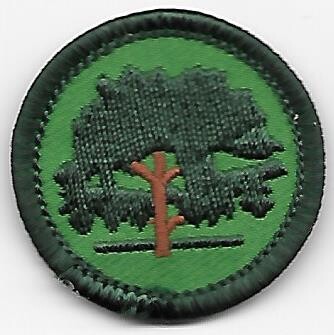Forest Explorer Central Maryland Council own Junior Badge (Original)
Requirements
Activities
1. Forests are generally cut to either clear land in order to construct houses and other buildings or as part of the management of the forest. Managed forests are harvested in order to make wood available for products. The harvest area is then replanted or allowed to regenerate in order for the forest to grow back again. (Regeneration is when acorns and other seed sources in the soil grow into trees). If fewer trees were harvested then less wood would be available for products we use everyday. Make a list of products that come from trees and forests that you use or are utilized in your daily life. Compare your list to this list: House framing, wood floors, plastic bags, pencils, furniture, mushrooms, nuts, maple syrup, fruit, charcoal and more.
2. Take a hike through the forest located in a park or by your home or meeting place. Use a tree guidebook or key to identify 6 trees within the forest.
3. Maryland is divided into 3 geographic regions and the change in geography is reflected in the native tree species found in each region. Find out the boundaries of each region and name 3 native trees in each region. Why aren’t the native trees identical in each region? What is different about each region that affects the native trees?
4. Learn how to plant seedlings, containerized and ball and burlap trees. Discuss how to care for the trees and seedlings after the planting such as how to water, mulch and fertilize correctly. Then plan a tree planting or participate in an Arbor Day or Earth Day Celebration. Maryland celebrates Arbor Day the first Wednesday of April while the National Arbor Day is the last Friday of April. Earth Day is celebrated on April 22.
5. Identify the benefits provided by the different forest layers (shade tree, evergreen, shrub and groundcover) at your school or home or meeting place. These benefits include air quality, water quality, erosion control, products, noise reduction and aesthetic appeal.
6. How many careers are involved in the care and planting of trees and forests? Think about the growing to planting to designing landscapes to maintenance to protection to planning to management to education to government’s role with trees and forests. Such professions include: arborists, landscape architects, foresters, nurserymen, planner, and government officials.
7. Create your own tree guidebook by make impressions of different leaves by leaf rubbings, ink prints or plasterof-paris impression and do bark rubbings to make impressions of different tree bark You could also create a scrapbook of the different trees in your area.
8. Measure the height of at least one tree. Tree height can be measured 2 different ways. The first method involves measuring the shade of the tree. First measure the girl’s height then measure her shadow length. Then measure the trees shade’s length. Do a ratio comparison to determine the height of the tree: tree’s height girl’s height ------------- = ------------- tree’s shadow girl’s shadow The second method uses the proportional measuring. Have a girl stand at the bottom of the tree. Have another student hold a ruler at arm’s length stiffly and backward until the top and bottom of the tree are at the top and bottom of the ruler. At this point, record where the top of the girl’s head appears on the ruler. Divide the length of the ruler by this number (A). Take the girl’s actual height and multiple it by (A) For example, if the girl’s height is 55 inches then the height of the tree is 55 inches x (A)
9. Draw a landscape of trees and forests in our world or your favorite special tree. Use any medium and display your work for others.
10. Maryland has adopted laws that protect trees and forests throughout the state. Find out more about the laws (Reforestation Law, Forest Conservation Act, and the Roadside Tree Law). Check out the Maryland Forest Service’s website for information. Discuss why these laws are in place and the benefits from them. Also read Dr. Seuss’s “The Lorax” .
